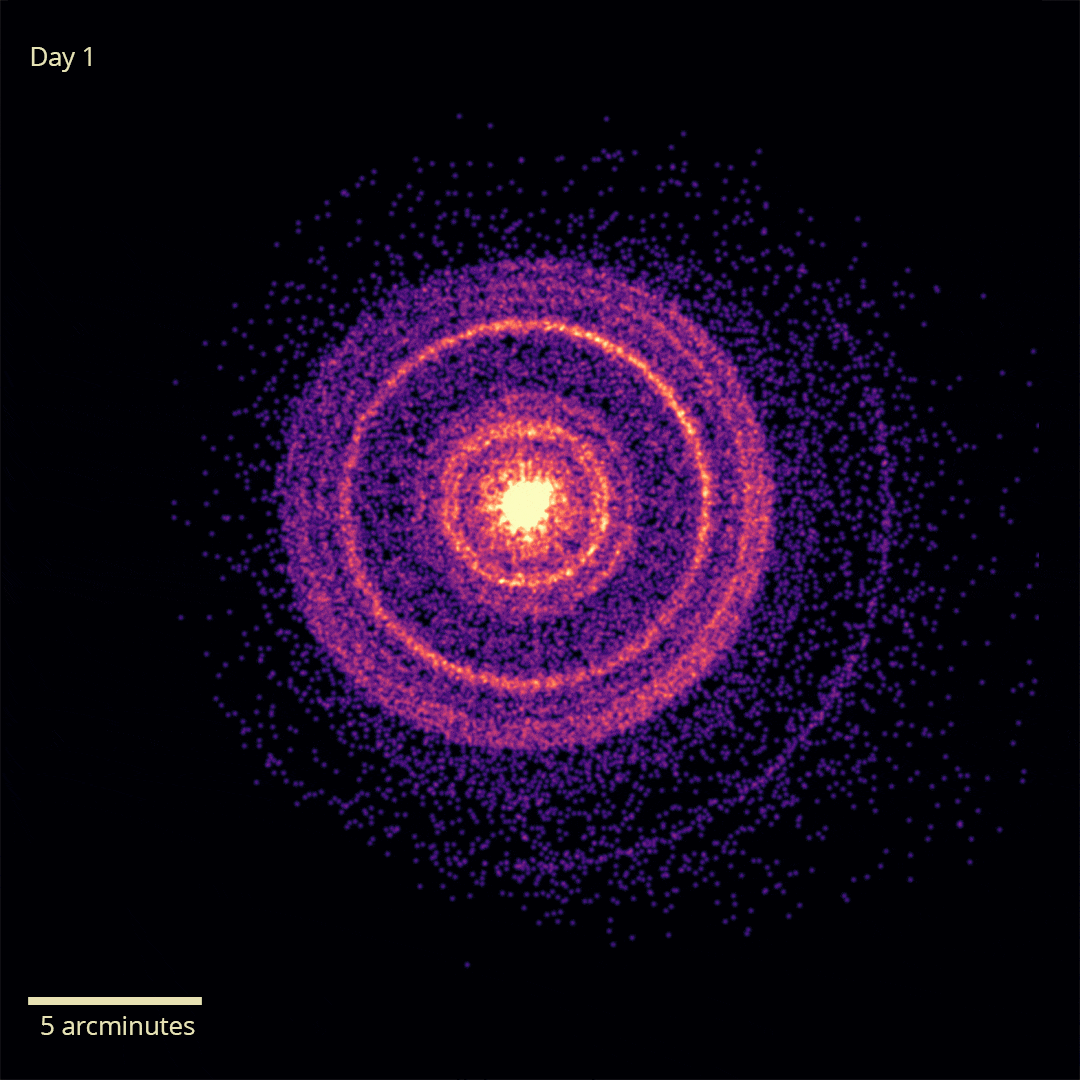Scientists Record GRB 221009A, the Brightest Gamma-Ray Burst in Cosmic History

A team of scientists from 17 countries, including physicists from HSE University, analysed early photometric and spectroscopic data of GRB 221009A, the brightest gamma-ray burst ever recorded. The data was obtained at the Sayan Observatory one hour and 15 minutes after the emission was registered. The researchers detected photons with an energy of 18 teraelectronvolts (TeV). Theoretically, such high-energy particles should not reach Earth, but data analysis has confirmed that they can. The results challenge the theory of gamma radiation absorption and may point to unknown physical processes. The study has been published in Astronomy & Astrophysics.
Gamma-ray bursts are the most powerful cosmic explosions, releasing an immense amount of energy. These bursts were first detected in the gamma range, giving them their name. They occur during the death of massive stars or the collision of neutron stars.
On October 9, 2022, several space-based gamma-ray observatories detected an exceptionally bright burst, later classified as GRB 221009A—the most powerful gamma-ray burst ever recorded. The burst's unprecedented brightness was so intense that it caused malfunctions in the gamma-ray telescopes of most orbital observatories, including Fermi, INTEGRAL, and Konus-Wind. In addition, the gamma radiation that reached Earth caused a significant disturbance in the ionosphere.

The radiation energy emitted by GRB 221009A over just one hundred seconds was equivalent to the combined radiation of one billion Suns over 97 billion years, even though the age of the Universe is only 13.8 billion years. Such events occur extremely rarely—once in a thousand years. However, it wasn't just the brightness that made GRB 221009A unique. The burst occurred 2.4 billion light-years from Earth, which is relatively close by the standards of the Universe. For comparison, the most distant known burst was recorded at a distance of approximately 13.2 billion light-years. As a result, the event sparked significant interest in the scientific community: by the end of 2022, seven papers had been published, and now there are more than 200.
Researchers are continuing to analyse data on GRB 221009A. For the first time, an international team of scientists from 17 countries, including researchers from HSE University, analysed data from photometric and spectroscopic observations collected at the Sayan Observatory one hour and 15 minutes after the gamma-ray burst was detected.
Photometric and spectroscopic observations are methods used to measure the intensity of electromagnetic radiation in the visible and infrared ranges, as well as its 'colour composition' (spectrum). The former makes it possible to determine the brightness of an object, while the latter reveals the chemical elements present in the emitting object and along the radiation path to the observer.
According to the scientists, the data analysis suggests prolonged activity of the central engine—a compact, massive object responsible for generating gamma-ray burst radiation. They also note that the environment surrounding the explosion changed from a denser one, shaped by the stellar wind, to a more rarefied one, similar to the interstellar medium.
The researchers were particularly interested in photons with an energy of 18 teraelectronvolts (TeV), which were recorded from the GRB 221009A source by the Large High Altitude Air Shower Observatory (LHAASO). Theoretically, such high-energy photons should not be detectable due to their interaction with optical photons in the intergalactic medium on their way to the observer; however, they somehow still reached Earth. The analysis reveals that the detection of photons with an energy of 18 TeV is unlikely according to existing models of intergalactic background radiation, and their detection from gamma-ray burst sources remains a unique occurrence.

Sergey Belkin
'The detection of high-energy photons allows us to test fundamental laws of physics, such as the constancy of the speed of light. However, there is no cause for concern yet, as the detection of such high-energy photons can still be explained by uncertainties in the intergalactic background radiation model, rather than a violation of Lorentz invariance—the fundamental principle stating that the speed of light is constant in all reference frames,' explains Sergey Belkin, doctoral student at the Joint Department of Space Physics with the Space Research Institute (RAS) of the HSE Faculty of Physics.
See also:
New Method for Describing Graphene Simplifies Analysis of Nanomaterials
An international team, including scientists from HSE University, has proposed a new mathematical method to analyse the structure of graphene. The scientists demonstrated that the characteristics of a graphene lattice can be represented using a three-step random walk model of a particle. This approach allows the lattice to be described more quickly and without cumbersome calculations. The study has been published in Journal of Physics A: Mathematical and Theoretical.
Scientists Have Modelled Supercapacitor Operation at Molecular and Ionic Level
HSE scientists used supercomputer simulations to study the behaviour of ions and water molecules inside the nanopores of a supercapacitor. The results showed that even a very small amount of water alters the charge distribution inside the nanopores and influences the device’s energy storage capacity. This approach makes it possible to predict how supercapacitors behave under different electrolyte compositions and humidity conditions. The paper has been published in Electrochimica Acta. The study was supported by a grant from the Russian Science Foundation (RSF).
Designing an Accurate Reading Skills Test: Why Parallel Texts are Important in Dyslexia Diagnosis
Researchers from the HSE Centre for Language and Brain have developed a tool for accurately assessing reading skills in adults with reading impairments. It can be used, for instance, before and after sessions with a language therapist. The tool includes two texts that differ in content but are equal in complexity: participants were observed to read them at the same speed, make a similar number of errors, and understand the content to the same degree. Such parallel texts will enable more accurate diagnosis of dyslexia and better monitoring of the effectiveness of interventions aimed at addressing it. The paper has been published in Educational Studies.
Internal Clock: How Heart Rate and Emotions Shape Our Perception of Time
Our perception of time depends on heart rate—this is the conclusion reached by neuroscientists at HSE University. In their experiment, volunteers watched short videos designed to evoke specific emotions and estimated each video's duration, while researchers recorded their heart activity using ECG. The study found that the slower a participant's heart rate, the shorter they perceived the video to be—especially when watching unpleasant content. The study has been published in Frontiers in Psychology.
Scientists Identify Personality Traits That Help Schoolchildren Succeed Academically
Economists from HSE University and the Southern Federal University have found that personality traits such as conscientiousness and open-mindedness help schoolchildren improve their academic performance. The study, conducted across seven countries, was the first large-scale international analysis of the impact of character traits on the academic achievement of 10 and 15-year-olds. The findings have been published in the International Journal of Educational Research.
HSE Scientists Reveal How Disrupted Brain Connectivity Affects Cognitive and Social Behaviour in Children with Autism
An international team of scientists, including researchers from the HSE Centre for Language and Brain, has for the first time studied the connectivity between the brain's sensorimotor and cognitive control networks in children with autism. Using fMRI data, the researchers found that connections within the cognitive control network (responsible for attention and inhibitory control) are weakened, while connections between this network and the sensorimotor network (responsible for movement and sensory processing) are, by contrast, excessively strong. These features manifest as difficulties in social interaction and behavioural regulation in children. The study has been published in Brain Imaging and Behavior.
Similar Comprehension, Different Reading: How Native Language Affects Reading in English as a Second Language
Researchers from the MECO international project, including experts from the HSE Centre for Language and Brain, have developed a tool for analysing data on English text reading by native speakers of more than 19 languages. In a large-scale experiment involving over 1,200 people, researchers recorded participants’ eye movements as they silently read the same English texts and then assessed their level of comprehension. The results showed that even when comprehension levels were the same, the reading process—such as gaze fixations, rereading, and word skipping—varied depending on the reader's native language and their English proficiency. The study has been published in Studies in Second Language Acquisition.
Mortgage and Demography: HSE Scientists Reveal How Mortgage Debt Shapes Family Priorities
Having a mortgage increases the likelihood that a Russian family will plan to have a child within the next three years by 39 percentage points. This is the conclusion of a study by Prof. Elena Vakulenko and doctoral student Rufina Evgrafova from the HSE Faculty of Economic Sciences. The authors emphasise that this effect is most pronounced among women, people under 36, and those without children. The study findings have been published in Voprosy Ekonomiki.
Scientists Discover How Correlated Disorder Boosts Superconductivity
Superconductivity is a unique state of matter in which electric current flows without any energy loss. In materials with defects, it typically emerges at very low temperatures and develops in several stages. An international team of scientists, including physicists from HSE MIEM, has demonstrated that when defects within a material are arranged in a specific pattern rather than randomly, superconductivity can occur at a higher temperature and extend throughout the entire material. This discovery could help develop superconductors that operate without the need for extreme cooling. The study has been published in Physical Review B.
Scientists Develop New Method to Detect Motor Disorders Using 3D Objects
Researchers at HSE University have developed a new methodological approach to studying motor planning and execution. By using 3D-printed objects and an infrared tracking system, they demonstrated that the brain initiates the planning process even before movement begins. This approach may eventually aid in the assessment and treatment of patients with neurodegenerative diseases such as Parkinson’s. The paper has been published in Frontiers in Human Neuroscience.


